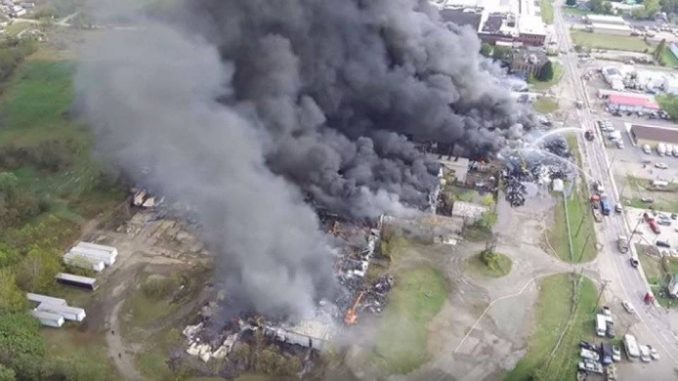Eyewitness Ames plant fire, Part 2: Corporate poison and politics
On Oct. 21, the Ames plant fire here lit up a week of polluted hell for Parkersburg residents. (See Oct. 31 workers.org for detailed coverage.)
But West Virginia has a long history of being one of the most heavily exploited states in the union, used primarily as an extraction site for corporations. This is coupled with an extremely bloody record against workers’ rights.
One of the worst industrial accidents in U.S. history, for example, happened when 750 workers, drilling the Hawk’s Nest Tunnel in the early half of the 1930s, died of silicosis. Workers were being forced to break through the 99.4 percent pure silica in Fayette County, W.Va., as part of a hydroelectric project. The silica the workers inhaled created extensive and fibrous nodules on their lungs. They found it harder and harder to breathe. Ultimately, many suffocated to death as a result.
In August 1985, a small cloud of toxic chemicals escaped from a Union Carbide plant in Charleston, W.Va. At least 135 residents were treated for eye, throat and lung irritation; 28 of the injured were admitted to nearby hospitals. The cloud of gas contained several chemicals, including aldicarb oxime, which is combined with methyl isocyanate to produce aldicarb, a compound used in pesticides. Health officials assured the public that everything was fine and the chemicals were “nontoxic,” despite numerous medical cases contradicting this narrative.
In January 2014, up to 300,000 residents in Charleston were without access to clean water for several days after a major chemical spill, and were facing long-term issues with contaminated household water systems. State environmental officials estimated that as much as 7,500 gallons of a chemical used to process coal (crude 4-Methylcyclohexanemethanol) flowed into the Elk River, a tributary of the Kanawha River.
In 2007, residents near DuPont and Chemours’ Washington Works plant near Parkersburg learned their water had been contaminated with the chemical C-8, used to make Teflon. Now, over a decade later, the companies have finally agreed to pay $670.7 million to settle the 3,500 cases in the class-action lawsuits that were filed.
In that decade, residents of Parkersburg reported a whole death-list of medical problems, including kidney cancer, testicular cancer, ulcerative colitis, thyroid disease and pregnancy-related hypertension, including preeclampsia and hypercholesterolemia.
Farmers also reported livestock affected by exposure to C8, with symptoms including bleeding from orifices, vomiting blood, tumors, seizures, blindness, tremors, foaming at the mouth and death. From the 1980s into the 1990s, DuPont and Chemours began to buy land from resident farmers and landowners for landfills, assuring them that what was to be dumped was ash, scrap metal and so on.
After years of reports of environmental and medical issues facing the community, some people began to dig to uncover the root cause. When the lawyer for one farmer uncovered the Teflon chemical link, Bernard J. Reilly, a legal counsel for DuPont, wrote in a company internal document: “The shit is about to hit the fan in WV … the lawyer for the farmer finally realizes the surfactant [C8] issue … Fuck him.” (tinyurl.com/jvfo3jo)
Polluted capitalist politics
This pollution is taking place within a 154-year history of corporate exploitation and stranglehold on state politics. The current West Virginia governor is billionaire Jim Justice, a personal friend and strong supporter of Donald Trump. Earlier this year, Justice joined Trump at a West Virginia rally to announce he was switching his party affiliation from Democrat (read Coalcrat) to Republican.
During the 2016 presidential campaign, Trump made several stops in West Virginia, where he spoon fed West Virginia workers false hopes of factories and mines opening up, dangling coal in front of our faces just like every other Tom, Dick and Harry politician that comes through our mountains.
West Virginians buy into these farcical narratives out of economic desperation. They gave Trump 489,371 votes, a landslide victory with 68.5 percent of the state’s total votes.
While Jim Justice, after several days of continuous chemical smoke in Parkersburg, has made some statements about the Ames plant fire, the Trump administration has made a total of zero comments about the Ames plant disaster. Odd, since he apparently “loved” us during the election year.
This, combined with the state’s delayed response to the disaster, as well as the city running out of funds and water to combat the fire, left many residents feeling abandoned by everyone and left to survive if they could.
Where the political background involving Trump becomes most significant is Trump’s proposed 31 percent budget cut for the Environmental Protection Agency. This would greatly reduce, if not strip, the resources needed to respond to emergencies such as the Parkersburg fire.
EPA staff and scientists at its regional offices across the country regularly respond to emergency calls from city and state officials during disasters such as this. Funds to respond to many of those calls, including from West Virginia officials, would no longer be available under Trump’s budget. So, in effect, this is what the Trump-Justice duo has in store for Parkersburg residents moving forward.
A class action lawsuit has been filed on behalf of Timothy Callihan and other residents. Defendants named in the suit are Surnaik Holdings of West Virginia LLC, SirNaik LLC, Polymer Alliance Services LLC, Green Sustainable Solutions LLC and Intercontinental Export Import Inc.
The full medical and environmental cost of this disaster remains to be seen. But with a state history of corporate coverups, state pandering and collusion with various corporations, with no regulations, zero social planning and little recourse for the citizens of affected areas such as Parkersburg, the outcome doesn’t look too good.


